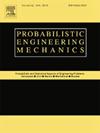Quantified active learning Kriging model for structural reliability analysis
IF 3.5
3区 工程技术
Q2 ENGINEERING, MECHANICAL
引用次数: 0
Abstract
A quantified active learning Kriging-based (qAK) methodology for structural reliability analysis is presented. The proposed approach is based on an updated probability density function (PDF), which is dominant in the vicinity of the limit-state surface. This PDF is created using weights based on an improved learning function called the most probable misclassification function. This function is used as a metric for efficiently updating the Kriging model, as it symmetrically quantifies the uncertainty of candidate points in terms of the model’s accuracy. The proposed approach accurately approximates the points that lie on the limit-state surface. Moreover, a probabilistic-based stopping criterion is proposed. The new support points are selected using the weighted -means algorithm and the sample from the updated PDF. Thus, the method does not require solving an optimization problem or using a sampling algorithm. The proposed qAK methods are more reliable and robust than previous implementations of the Kriging method for structural reliability assessment. The proposed approach is presented within the framework of standard reliability methods, i.e., the Monte Carlo and the Subset Simulation methods. The efficiency of the proposed qAK methods is demonstrated with the aid of six case studies.
用于结构可靠性分析的量化主动学习克里金模型
本文介绍了一种基于克里金法的量化主动学习(qAK)结构可靠性分析方法。所提出的方法基于更新的概率密度函数(PDF),该函数在极限状态面附近占主导地位。该概率密度函数使用基于改进学习函数(称为最可能误分类函数)的权重创建。该函数被用作有效更新 Kriging 模型的度量标准,因为它以模型的准确性为基准,对称地量化了候选点的不确定性。所提出的方法可以精确地逼近极限状态面上的点。此外,还提出了一种基于概率的停止准则。新的支持点是通过加权 K-means 算法和更新后的 PDF 样本选出的。因此,该方法无需解决优化问题或使用采样算法。与以往用于结构可靠性评估的克里金方法相比,所提出的 qAK 方法更加可靠和稳健。所提出的方法是在标准可靠性方法(即蒙特卡罗法和子集模拟法)的框架内提出的。拟议的 qAK 方法借助六个案例研究证明了其效率。
本文章由计算机程序翻译,如有差异,请以英文原文为准。
求助全文
约1分钟内获得全文
求助全文
来源期刊

Probabilistic Engineering Mechanics
工程技术-工程:机械
CiteScore
3.80
自引率
15.40%
发文量
98
审稿时长
13.5 months
期刊介绍:
This journal provides a forum for scholarly work dealing primarily with probabilistic and statistical approaches to contemporary solid/structural and fluid mechanics problems encountered in diverse technical disciplines such as aerospace, civil, marine, mechanical, and nuclear engineering. The journal aims to maintain a healthy balance between general solution techniques and problem-specific results, encouraging a fruitful exchange of ideas among disparate engineering specialities.
 求助内容:
求助内容: 应助结果提醒方式:
应助结果提醒方式:


